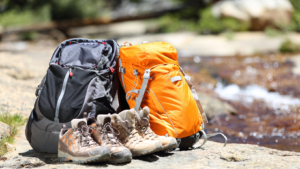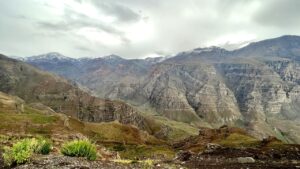Peru’s Colca Canyon, renowned for its breathtaking beauty and rich cultural history, is a must-visit for every adventure traveler. This comprehensive guide delivers all the essential details, from the best hiking routes to practical tips for a memorable journey.
Overview
The Colca Canyon dwarfs the Grand Canyon in depth. It’s a spectacular natural wonder with a depth of about 3,400 meters (11,155 feet) at its deepest point. This makes it twice as deep as the famous Grand Canyon, making Colca the world’s second deepest canyon after Tibet’s Yarlung Zangbo Grand Canyon.
The canyon formed by a geological fault between two massive volcanoes – Nevado Ampato and Nevado Mismi. Over millions of years, the relentless Colca River eroded the colossal fissure we see today. The canyon walls display striking colors, from deep reds and oranges to muted grays and browns, created by various mineral compositions. Although a testament to nature’s relentless forces, the canyon is also home to a vibrant human history and cultural treasures.
History of the Colca Canyon

The Colca Canyon region has been inhabited for thousands of years, with evidence of human settlements dating back to 6,000 BC. Around 600 AD, the Collaguas and Cabanas tribes flourished here. They developed advanced agricultural techniques and built the intricate terracing system still visible today. These stone-walled terraces, carved into the steep canyon walls, allowed crop cultivation in an otherwise inhospitable environment.
The Incas arrived around 1450 AD, transforming the region. Through strategic alliances and marriages with local rulers, they gained control over agriculture and the economy. Additionally, they expanded the existing terracing system and built impressive stone structures like the Uyo Uyo ruins near Yanque, which served as a resting place for Inca messengers and administrators.
After the Spanish conquest in the 16th century, the region was largely neglected until tourism flourished in the 20th century. Today, the Colca Canyon’s modern residents, many descendants of the Collaguas and Cabanas tribes, continue living and working here, carrying on traditional agricultural practices handed down through generations.
How to Reach Colca Canyon
The journey to Colca Canyon typically begins from the city of Arequipa, which is approximately 160 kilometers (100 miles) away. Driving to Chivay, the canyon’s gateway town, takes about three hours along a winding mountain road offering stunning Andes views.
From Chivay, you can continue deeper into the canyon to smaller towns like Yanque and Cabanaconde. The road from Chivay to Cabanaconde winds along the canyon’s edge with sheer drops on one side and towering walls on the other, making for a thrilling experience.
Geography and Elevation

The geography and elevation of the Colca region are incredibly varied. Chivay, the principal town, sits midway between the valley’s highest and lowest elevations at around 3,600 meters (11,800 feet) above sea level. Meanwhile, the highest point, Cabanaconde Volcano, rises to an impressive 6,228 meters (20,456 feet), while the canyon floor dips to a depth of 3,800 meters (12,467 feet).
The best way to truly appreciate the grandeur of the Colca Canyon is to explore it on foot. There are numerous trekking routes that wind through the canyon, each offering unique viewpoints and perspectives on this natural wonder. From the breathtaking Cruz del Condor viewpoint, where you can witness the majestic Andean condor in flight, to the lush Sangalle oasis with bubbling natural hot springs, the canyon’s varied landscapes are sure to leave you in awe.
Weather in Colca Canyon

The weather in Colca Canyon is typical of the Andes and high-elevation destinations in Peru. The region experiences a rainy summer season (January to March) and a dry winter season (May to November). During the dry season, the weather is generally warm and sunny during the day, with temperatures ranging from 15°C to 25°C (59°F to 77°F). However, it can get quite chilly at night, often dipping below freezing.
It’s crucial to dress in layers when visiting Colca Canyon, as temperatures can vary significantly throughout the day and depending on elevation. Mornings and evenings can be quite cold, while midday can be quite warm, especially when hiking in direct sunlight.
Tour Options
There are several ways to explore the Colca Canyon, depending on your fitness level, time availability, and personal preferences. Here are some popular tour options:
Day Tours
Day Tours provide a convenient way to explore major sights if you have limited time. These tours typically include transportation from Arequipa, visits to attractions like the Cruz del Condor viewpoint, Chivay town, and Uyo Uyo ruins, and a stop for lunch at a local restaurant.
Two-Day or Three-Day Tours
If you have more time, consider a two-day or three-day tour, which allows for a more relaxed exploration of the region. These tours usually include an overnight stay at a local hotel or lodge in Chivay or Cabanaconde, giving you the opportunity to soak up the tranquil atmosphere of the canyon in the evening and early morning. Additionally, you’ll have more time to explore villages, interact with residents, and participate in cultural activities.
Trekking Tours
For the more adventurous, multi-day trekking tours offer an in-depth experience of the Colca Canyon’s natural beauty and cultural richness. These tours take you along the canyon’s many hiking trails, through indigenous communities, and past stunning natural features like waterfalls, hot springs, and ancient ruins.
Trekking tours can range from three to seven days, depending on the route and level of difficulty. Some popular trekking routes include the Colca Canyon Classic Trek, which involves descending to the canyon floor and then ascending back up, and the Tapay Trail, which connects the villages of Cabanaconde and Tapay while passing through remote hamlets and Inca ruins.
Hiking Trails in Colca Canyon

The Colca Canyon boasts a range of trekking routes, each offering a unique perspective on the region’s landscape and culture. Here are some of the most popular trails:
Classic Route
The Classic Route, also known as the Colca Canyon Trek, is a challenging but rewarding two-day hike from Cabanaconde to the canyon bottom and back up. It begins with a steep 3,000-meter (9,842-foot) descent into the canyon, offering stunning views of the canyon walls and Colca River below. After spending the night at a basic lodge or campsite, you’ll face a grueling ascent back to Cabanaconde the next day.
Ampato Trail
The Ampato Trail is an adventurous option looping around Ampato Volcano, one of the two volcanoes forming the Colca Canyon. This multi-day trek is only recommended for those fully acclimated to the high altitude, as it involves significant elevation changes, reaching up to 5,200 meters (17,060 feet). Along the way, you’ll pass through remote villages, traverse rugged terrain, and be rewarded with stunning volcano and Andean landscape views.
Tapay Trail
The Tapay Trail is a popular three-day route connecting Cabanaconde with the remote village of Tapay. This trek takes you through various landscapes, from the deep canyon to high mountain passes, and offers opportunities to interact with local communities and see their traditional way of life. You’ll also pass by Inca ruins, pre-Inca terraces, and have the chance to spot wildlife like the Andean condor and vizcacha (a type of chinchilla).
Cabanaconde to Lake Mucura Trail
This eight-hour hike takes you from Cabanaconde to Lake Mucura, a pristine alpine lake nestled at an elevation of around 4,500 meters (14,764 feet). The trail offers breathtaking views of the Ampato Volcano reflected in the lake’s surface, as well as opportunities to spot wildlife like vicuñas (a type of wild camelid) and various bird species.
Practical Information
Before embarking on your Colca Canyon adventure, consider a few practical details.
Acclimatization
Acclimatization is crucial given the high altitude. Spend at least two to three days in Arequipa or another high-altitude location before heading to the canyon, and avoid strenuous activity for the first few days. This will help you avoid altitude sickness, which can ruin your experience and even be dangerous if left untreated.
Entrance Fee
All visitors to the Colca Canyon must pay an entrance fee of 70 soles (approximately $20 USD as of 2023). This price is subject to change, so it’s best to check the current fee before your visit. The entrance fee can be purchased at any checkpoint, and you should keep your ticket handy as you may be asked to show it at various points during your visit. The fee goes towards the canyon’s maintenance and conservation.
Where to Stay in the Colca Canyon
There are many accommodation options in and around Colca Canyon for various budgets. You can stay in towns like Chivay, Yanque, or Cabanaconde, which have hotels, hostels, and guesthouses.
However, for a truly immersive experience, consider booking a homestay in one of the indigenous communities. This way, you’ll experience the traditional way of life firsthand and learn about the local culture directly from your hosts.
What to Pack for Colca Canyon

When packing for your Colca Canyon adventure, be prepared for a range of weather conditions and physical challenges. Even during the dry season, temperatures can vary significantly between day and night, and the terrain can be rugged and demanding.
Key items to pack include:
- Sunblock and a hat to protect against the intense sun, especially at higher altitudes.
- Insect repellent to guard against bugs, especially in the oasis areas and during the rainy season.
- A trekking pole or hiking staff to help with balance and stability on the steep trails.
- A raincoat or poncho for unexpected showers, even during the dry season.
- Plenty of water and high-energy snacks to keep you hydrated and energized during your hikes.
- Warm clothes, including a down jacket, gloves, and a hat, for the chilly evenings and early mornings.
- Sturdy, broken-in hiking boots with good ankle support and traction.
- A small backpack or daypack to carry your essentials while hiking.
- A basic first-aid kit, including altitude sickness medication.
- A headlamp or flashlight, especially if you plan on camping or staying in basic lodges.
Conclusion

In conclusion, Colca Canyon is undoubtedly one of Peru’s greatest natural treasures. It offers breathtaking landscapes, rich cultural heritage, and outdoor adventures. Whether exploring on a day tour, multi-day trek, or leisurely village stay, you’ll be captivated by its grandeur and leave with unforgettable memories.
However, to truly appreciate its beauty and complexity, plan ahead, prepare for high-altitude trekking challenges, and respect local communities and traditions. With proper preparation and an open mind, Colca Canyon will reward you with an unparalleled experience. So, start planning your adventure today!